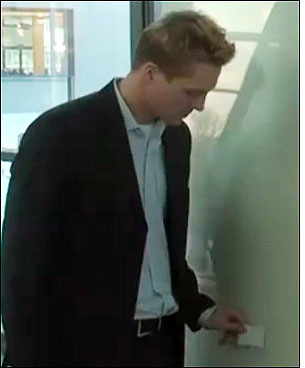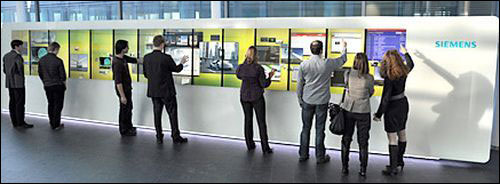Visitors being escorted through the lobby of Siemens‘ Central and Eastern European headquarters, located in Vienna, Austria, must feel like they’re walking through cyberspace: The area is outfitted with a 10.5-meter-long (34-foot-long) bank of RFID-enabled interactive displays that respond to each visitor’s presence, inviting that person to interact with multimedia content presented on the screen.
The stretch of high-definition touch screens shows content from various social-media sources that has been collected and contextualized. According to its designer, Austrian firm Uma, the tool is the first semantic display product on the market. A semantic display provides multimedia content that is collected via a semantic search engine, which employs the rules of semantics—or language meaning—to narrow down search terms, instead of using the type of ranking algorithms on which Google and most other search engines depend.
The displays may be equipped with “person-tracking” technology that allows the system to react to the presence of someone standing before or passing by a display. Those moving close to the displays can be recognized in two ways: either through an optional movement sensor that recognizes movements using a real-time 3-D sensor camera that detects motion at a distance, or via an optional RFID solution. The latter method identifies individuals wearing an RFID badge or carrying an RFID card as they pass by the RFID readers mounted near the touch screens.
When the RFID option is used, multimedia content pre-selected and saved on the product’s content-management system—such as pictures or slideshows—is linked to the unique ID number stored on a specific item’s RFID tag.
Once the system recognizes a particular tag number, the content is displayed so that the badge or card holder (often a visitor) can view the information that the host (frequently a Siemens employee) wants him or her to see.
The readers are mounted at the far left and far right of the stretch of displays, inside the frame encasing those displays. The interrogators and tags being used are manufactured by Phidgets; at present, Siemens is using approximately 10 RFID badges.
Siemens has installed the display—known as SKIN, for Semantic Knowledge Information Network—primarily as an internal communications tool at the company’s regional headquarters. The firm is using both the optional 3-D sensor camera and the RFID customization. Upon approaching the display, a visitor or employee can learn more about Siemens’ business processes, interact with company information, view digital art or watch local or global news, in addition to viewing the content pre-selected for a particular badge holder.

In an Uma press release, Brigitte Ederer, Siemens’ head of corporate human resources and labor director, said she liked the idea of the screen because it makes Siemens “tangible” and “brings the exchange of ideas and experiences to a completely new level.”
According to Christian Dögl, Uma’s CEO, the product’s automated semantic content curator reduces the amount of work that the content provider—in this case, Siemens—must undertake in order to prepare information for display. “It’s an impressive tool for explaining complex topics,” he states.
SKIN displays can be rented, leased or purchased, in various lengths and models. A system such as that utilized by Siemens in Vienna, with its seven display panels, costs approximately €50,000 to €60,000 ($67,000 to $81,000) per display panel to purchase, Dögl says.
On the market for roughly seven months, SKIN displays (sans the RFID or 3D sensor options) are also being used at the visitors’ center of the Austrian Power Grid, in Vienna, to illustrate how electric power is transmitted.
In addition, retailer SportScheck is testing displays before installing one at a new flagship store, most likely located in Munich. The displays will be employed to capture shoppers’ attention, an Uma representative reports, and will probably not include the RFID option.
Dögl says he expects to sign on new customers in Germany, the United States and Switzerland by the end of this year. He sees a particularly good application for SKIN displays at trade fairs, for companies looking to inform attendees about their products in an entertaining way, or for trade-fair operators interested in renting out advertising space on the display. What’s more, he sees promise in the retail area, for stores that want customers to be able to learn details about products prior to purchasing them.


